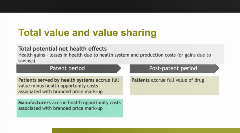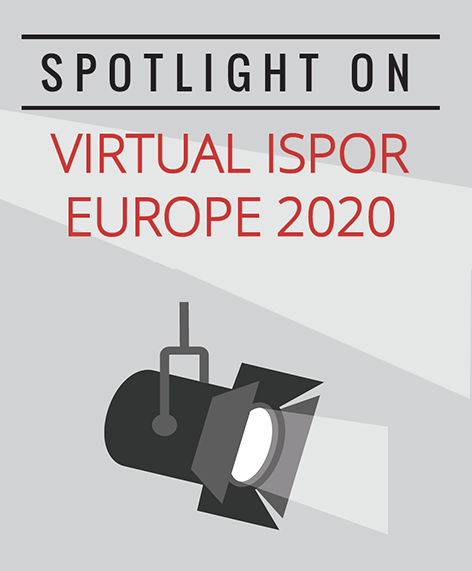How Should Pharmaceutical Companies and Patients Share the Value Generated by New Medicines?
Nazneen Fatima Shaikh, BPharm, DPharm, Department of Pharmaceutical Systems and Policy, West Virginia University, Morgantown, WV, USA; and Purva Parab, BPharm, MS, Virginia Commonwealth University, Richmond, VA, USA
An exciting session on value sharing was kicked off by Danny Palnoch, BSc, Head of Medicines Analysis, Strategy and Policy, NHS England and NHS Improvement, London, United Kingdom. Key questions addressed in this session include: 1) How is the value of branded medicines currently shared between pharmaceutical companies and patients served by health systems? 2) Is this appropriate given its expected effects on global R&D (research and development)? and 3) Should value sharing differ when publicly funded R&D has contributed to product development? Each of the panelists touched upon these questions and provided insights from different perspectives based on their working background.
Value can be measured as the societal value, health opportunity cost, and health technology assessment (HTA) body cost/quality of life year threshold. Critical issues to consider when value forms the cornerstone of pricing are multiple measures of value, lack of consensus on the time period to measure value, and the means to account for public R&D funds. In-patent price should be set to maximize aggregate surplus. The industry would have no incentive to innovate and develop new products when the in-patent prices are close to zero and the consumer surplus cannot be generated. There is a theoretical optimal in-patent price for new products that would maximize aggregate consumer surplus.
Value of Pharmaceutical Innovation
The value of pharmaceutical innovation is created when a therapeutic intervention delivers incremental benefits to patients and caregivers and reduces costs to health systems. It is determined by the level of price and duration of exclusivity. Value frameworks combined with specification of willingness to pay are instruments that allow policymakers to direct pharmaceutical R&D efforts. However, literature on shared value between pharmaceuticals and patients is limited and a few examples were provided by Jens Gruëger, PhD, Boston Consulting Group, Zurich, BW, Switzerland. The oldest study presented in the session reported 5% of the social surplus appropriated by the manufacturer for HIV/AIDS drugs, and the most recent one had 25% and 37% for lipid lowering drugs and chronic obstructive pulmonary disease (COPD), respectively. The share of value provided to industry is expected to have effects on global R&D.
“Providing a larger share of the value to industry results in a larger number of products reaching the market.”—Jens Gruëger, PhD
Political decisions also play a role in how value is determined because different countries use different methods; cost-effectiveness thresholds, case-by-case basis, and individual price negotiations between payers and industry. Consequently, the contribution of countries to innovation also differs with the United States identified as one of the overpaying countries. Finally, the value sharing for products developed by publicly funded R&D could be complicated because R&D is a complex ecosystem. Public and private funding was referred to as complementary, because public funding is more focused on basic research whereas private funding dominates discovery milestones, manufacturing, and drug development phases. “My experience from working in the industry is that a lot of the products that we bring into market are sourced from other players; academia, start-up companies, and other pharmaceutical developers,” he said. Gruëger concluded by stating that value-based pricing rewards innovation, and that leads to better outcomes and lower costs.
Total Value and Value Sharing
Beth Woods, MSc, Centre for Health Economics, University of York, York, United Kingdom, began by identifying that previous studies have estimated drug manufacturers receiving up to 70% of the value share and went ahead to describe a framework for estimating value and value shares (Figure 1). The total potential net health effects were health gains minus losses in health due to the health system and production costs. The framework provides value both the in-patent and postpatent periods. One of the examples discussed using the framework was about value sharing based on the cost-effectiveness threshold. If the manufacturer prices the product at the threshold, Woods said, then it accrues full value during the in-patent period and patients accrue in the postpatent period.
Figure 1. Framework for Total Value and Value Sharing.

To provide real-world context, Woods presented a case study of NICE-approved products. It demonstrated the value sharing between patients and manufacturers for a list of products where the majority of them had higher manufacturer shares. Answering the question if the current value sharing is appropriate given the expected effects on global R&D, Woods commented, ”From the perspective of (the) healthcare system and the patients it serves, this level of pricing is not appropriate because it incentivizes future innovation at prices that will reduce overall health.”
“From the perspective of (the) healthcare system and the patients it serves, this level of pricing is not appropriate because it incentivizes future innovation at prices that will reduce overall health.”—Beth Woods, MSc
Welfare Economic Framework
Patricia Danzon, PhD, The Wharton School, University of Pennsylvania, Philadelphia, PA, USA, addressed the topic within the context of the Welfare Economic Framework that is designed to encourage optimal R&D. In simple terms, the theory is that the innovator’s price should reflect up to the incremental value. Three important caveats were discussed; incremental value/price may decline over a product’s patent life due to the entry of similar products into the market, the innovator’s price should vary inversely with population served, and producer versus public shares of value created should reflect their respective shares of costs.
Danzon provided an example on the subject of COVID-19 vaccines, where she described the estimation of public share of costs for the vaccine. Because of the significant public funding for COVID-19 vaccines, the private out-of-pocket cost, time, risk, and capitalized cost has been reduced substantially. Overall, based on the framework and considering the caveats, value-based pricing should be the starting point, and incremental value based on willingness to pay should be the launch price, however, postlaunch pricing should consider the market entry of similar products during the patent life. Moreover, high volume (population) should reduce price and public share of capitalized R&D should be provided in the form of royalty to the government.
Consensus for Decision Making
In conclusion, the session panelists (Figure 2) discussed sharing value between pharmaceutical companies and patients based on different perspectives and agreed that there are concerns/issues that need to be addressed to make the process streamlined. Getting consensus on multiple aspects of value measurement and public funding would help increase the importance of value in pricing and reimbursement policies.
Figure 2. Session panelists (clockwise): Patricia Danzon, Jens Grueger, Beth Woods


